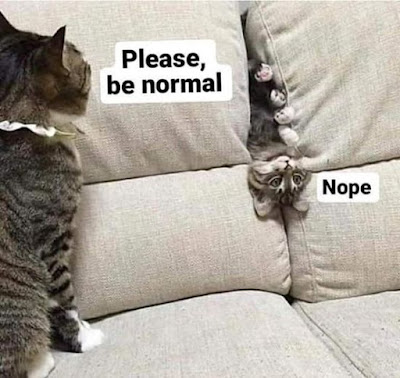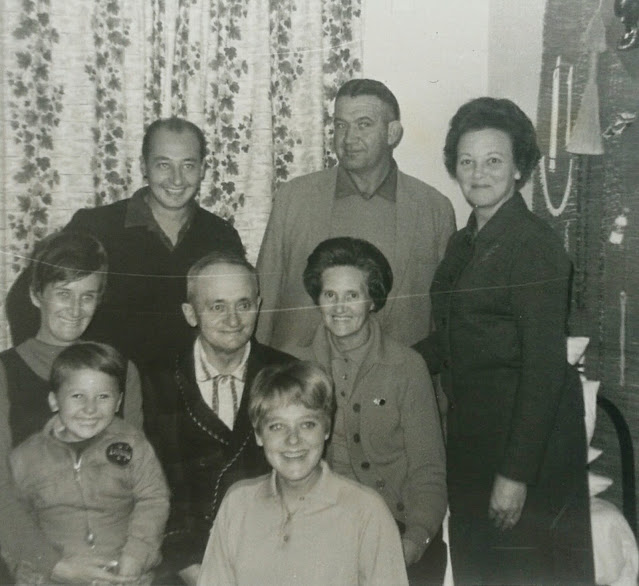There's a Bat in the Batman Logo?
or
"Not Seeing the Forest for the Trees"
If you haven't read this post, please do that first. The story follows on from there.
Okay, back to "coming out":
At the end of our sixth session, the psychologist asked if anyone had ever suggested I might be neurodivergent and gave me a test to take home. Long story short, it turns out I'm autistic*, have been all along, always will be. Your present disbelief is a compliment for how I learned to use my intellect to mask my autistic traits. I know I don't "look autistic" (what does autistic look like?). I certainly don't "feel autistic". Even with a professional diagnosis my reaction was the same as yours: I didn't believe it.
I do not avoid eye contact. I know "wearing his heart on his sleeve" does not mean a real heart or a real sleeve. I
understand facial expressions. My interests are the
opposite of restricted. I abhor sameness and routine. I do not flap my
hands to calm myself, FFS, and what remains of my childhood
sensory issues is negligible: I don't wear linen, wool, or collars. I'm
introverted, so I dislike big gatherings and have to recharge in solitude after a party. I prefer
one-to-one communication. I detest phone calls. Loud
noises scare me. These remnants do not, however, cause me "clinically significant impairment".
For most of my life I did not see the bat in the Batman logo. On t-shirts in shopping malls, in printed comics, on stickers, I saw two blunt, comic-like front teeth at the top and two or four larger teeth at the bottom. For ease of understanding, in the first image below the "teeth" would be yellow and in the second, pink:
Before I saw the bat for the first time - out of the blue on a random day in my late twenties - I simply didn't know it was there. I'd found it a bit odd that Batman would be represented by these comic-type teeth, but hadn't thought any more of it. It was like that with the unwanted diagnosis. Someone pointed out what they saw and I wanted to keep my mind open to the possiblity, but failed to perceive the proverbial bat.
Yet my score on the test paper stared at me from the desk. In a model where 65 is the cut-off point for a clinical ASD diagnosis and 80 and above ensures one has Asperger's Syndrome**, my score was 85. I decided to find out more. How could it be that I spent five decades on this earth before someone noticed? How the actual fuck did I not see this myself? Weeks, and later months passed as I devoured many scholarly research articles, TED Talks, YouTube videos, blogs, vlogs, and podcasts by professors, activists and influencers. Yes, there are autism influencers (not to be confused with autism scholars). The majority of the "I have Asperger's" talks were presented by an array of thoroughly displeasing people. I could not identify with the speakers and felt deep shame for not wanting to associate with "them".
I wasn't like them, didn't look like them, didn't act like them, didn't speak like they did, didn't feel what they said they felt. Their experience didn't resonate with me at all. I searched for just one autistic spokesperson who wouldn't be uncomfortable to watch on account of their alienating appearance or distracting behaviour. But I was looking for more than appearances. I needed to find an experience that reflected mine of seeming to fail to belong even in the "autistic community". I needed a model.
That's when I
discovered adult-diagnosed autistic women like YoSamdySam and Laura Zdan and, as mentors, autistic autism researchers Dr Jac Den Houting and Sarah Hendrickx. Most of the activists I'd seen before were nerdy men, or women like Hannah Gadsby, whom I appreciate, but do not wish to imitate. The overwhelming majority of ASD research is about men. And all the tests are designed
to diagnose men and children.
"Ageing women with autism [are] a cohort that's virtually undetectable in existing studies":
Turns out adult autistic women are ridiculously under-diagnosed. There are a lot of us, I learnt, between thirty and eighty, only being discovered now. Autism researcher and trainer Sarah Hendrickx wrote seven books on ASD before finding out she was on the spectrum. Let that sink in: not even an expert on autism knew she was autistic herself, because her autism looked different.
[From] an increasingly vocal female autistic population, especially through social media and blogging, we are starting to see some patterns and shared experiences that at first glance appear to entirely contradict the traditional triad of autistic cognitive processes, but on closer examination, actually reveal them [...] to be presented in a different way
- Sarah Hendrickx
When I was a child the autism spectrum may as well not have existed. I was considered clever and self-willed (eiewys). Recent enquiries to cousins confirmed I spoke early, and a lot. This made me lean towards rejecting the unwanted diagnosis: the very definition of ASD includes late speech or total lack of speech. When it comes to present-day confirmation of childhood traits the loss of my parents plus being an only child puts me at a disadvantage. I vaccillated for months between "I am" and "I'm not", trying to remember, and reading, reading, reading.
"[F]emales often love to talk from a young
age and may have precocious vocabularies, which makes them appear very
social and hence no tick in the autism box."
An image started to surface: my Gran and I in a faded Kodak print with a white border. We're standing on an improbably green lawn in front of a too-white Karoo farmhouse. My Gran wears a navy polyester two-piece. Next to us is a round steel table, painted white, with an iced birthday cake on top. Ouma tilts the cake at the camera. I'm dressed in all white with strappy shoes and knee-high socks with frilly lace and a dress with a pleated skirt bought for, I think, my fifth birthday. I don't have the photo anymore. I threw it away to get rid of the memory. (It didn't work.) My shoulders are slumped, arms limp like cooked spaghetti at my sides, chin hanging on my chest, long yellow hair obscuring my features. Every part of me screams I don't want to be there. Dikmond, they called me. I spoiled the photo that day, because I hated the dress, I bewailed having my hair brushed, the shoes were too big and the sock elastics too tight, and I wanted my mother to get the instamatic camera out of my face. I did not have a meltdown - by age five I'd already learnt to make it go inside.
"[A]s a woman [...] you’ve probably become adept at covering up traits and behaviour that others have told you is unacceptable. Women are generally raised and expected to be compliant, so diagnostic markers of autism are often self-suppressed and internalised."
I discovered that, as with almost every other autistic trait, verbality plays out differently in girls: we're as likely to speak too much as not speak at all. We may also learn very early to shut down instead of act out. My dad had to tell me once that I should "learn to reign in my little temper" and I complied by imploding from there on, turning my anger against myself. It follows that I would be diagnosed with major depression as an adult. For the first time I understand now that the anger was righteous and justified.
Nobody saw me.
Nobody except my mom, that is. Without a name for it, she understood when I didn't want to go to school because I was overwhelmed by anxiety about the constant pressure to excel. She didn't understand about the scratchy clothes, though, or the restrictive elastics in sleeves and panties that I secretly cut through using her heavy dressmaking scissors. Sometimes I tore my clothes in frustration. I could wear nothing tight like elastics in knee socks. Polo necks strangled me. Printed name lables sewn onto the soles (!) of white ankle socks for boarding school drove me to distraction. I was astonished to discover one can buy seamless socks for autistic children today. I still cut the labels off my clothes, prefer boy shorts or knickers with no leg elastic, can't stand a belt or a hat and the one time I tried on shapewear I nearly failed to suppress a panic attack in the changing room.
“A very high functioning woman, for example, who has learnt to
camouflage
her autism, may be rated by professionals as having very mild autism, when in fact she suffers a great deal with mental health problems as a
result of constantly trying to appear ‘normal’.”
It is near impossible to spot early childhood difficulties with social interaction if you spent your first six years an only child on a relatively remote Karoo farm. I had cousins who visited for holidays, friends from town (always older) and the neighbours' much older children were summoned to birthday parties, but I didn't have everyday friends my own age. My daily companion was my nanny and I adored her. The only event with which to retrospectively judge interaction with my peers was when I went to the little nursery school in town one morning while my mother went shopping. I had no idea how to interact with the foreign beings (children my own age) in a foreign place (a classroom and structured playground) with foreign rules. The teachers had to phone my mother to fetch me. I guess I was still doing meltdowns at that stage.
"(T)hat is a big thing about being on the spectrum. It is lonely. I find it
very difficult to connect to others, because my brain takes me to
places where nobody else lives. - Hannah Gadsby
As for "restricted interests", I thought it was normal for pre-teen girls to be interested in books and horses to the exclusion of everything else, even boys. Those whom I knew then may remember every oral in class being about horses; every composition, every picture, every after-school hour and every weekend. My preoccupation with horses alienated me further from my peers, I suspect. I also lived in and through the books I read and took on the personality of the protagonist. I'd be this character one week, that one the next, no matter how far-fetched or inappropriate the embodiment. Anyone but myself. Later I would do that with film roles, too, and pop singers, even the odd historical figure. I spent months being Cindy Lauper and years an alienated character in a Bruce Springsteen song. Not being like them, but being them. Erasing me.
Above all I tried to be perfect. My early losses may have been as much to blame for this absence of authenticity as any amount of autism was. It's futile to try to untangle trauma from neurology here: they're woven together so smoothly as to be indistinguishable. And what would be the point of saying, "this was trauma" and "this was autism"? I'd rather classify less and integrate more. As an adult I dealt with the challenges of a husband with an alcohol problem by borrowing books on co-dependency from the library (before Google) and studying everything I could on emotional intelligence (a new concept in the nineties) and the building blocks of psychologically sound relationships.
In my experience, autistic females [...] study people as an object, an alien species, in a bid for understanding and perhaps acceptance. I have met many women who have studied psychology, anthropology, religion, genetics and many other wide and varied loose ‘people’ topics to try and see where they fit in the world in its broadest sense. Fascinations with celebrities, serial killers and historical figures feature frequently along with the devouring of self-help books and endless efforts to improve, change and belong have led to the individual themselves being their own special interest.
When my childhood religion no longer covered my spiritual needs I registered for a year of undergraduate Religious Studies, formerly known as Comparative Religions. Struggling to understand how a beloved cousin was affected by the Border War morphed into academic research and postgraduate study. In short, my solution to any kind of uncertainty whether social, spiritual, sensorial or behavioural, was to make an intellectual study of it. This has not changed. The academic world probably remains the kindest environment for autists without intellectual disabilities (formerly known as HFA or high-functioning autistics). My neurological toolbox includes the ability to hyperfocus, see patterns where others might not (especially handy in the study of structural linguistics), think idiosyncratically and conceptualise new ideas. Even pre-diagnosis I'd planned a future in academia, with hindsight a sort of sheltered employment where intellectual honesty is rewarded and eccentricity almost a requirement. Case in point, the inimitable barefoot Postdoctoral Research Associate Jac den Houting:
If this is the only information you take in about autism, ever, it's probably more than most people would do. Thank you. The concepts they explain are important and I encourage you to think more about the neurodiversity paradigm and the medical versus social model of disability. We may also do well to reconsider where autism research funding goes in South Africa.
“Those who have embraced the neurodiversity paradigm, and who truly understand it, do not use pathologizing terms like ‘disorder’ to describe minority neurological variants like autism.”
While I did not stay in the safety of the academic world, I managed - as the diagnostician pointed out - to accidentally engineer my life to suit my neurological needs. I live in a quiet place with only one other person and no phone network coverage. My work has me meeting people only to show them to their self-catering accommodation, which I prepared alone, and even that interaction could be avoided with self check-in. Social interaction is mediated by a screen or planned in advance. Now that I know why I need to lie down in a darkened room and practice a kind of deliberate shut down in the wake of extended visits with family and friends I can actively allow for recovery time. I crave connection like any human, only I prefer friends in small numbers. My uncle's recent eightieth birthday was the final large gathering I attended. I no longer do phonecalls if there is another way to convey a message.
Why am I telling you this? Because I want you to understand that when I don't take or make a phonecall or attend an event it's not about you. When I leave the room during a visit (smoking used to make this a lot easier!) it's because I need to escape sensory overload before it wears me out. This is especially true in noisy restaurants and where kids run around. When I stop manufacturing aswers to small talk it's because small talk is torture to me and I'd rather sit in companionable silence than make conversation. You will not see me on my low-functioning days. Just know that I have them and sometimes they last for weeks. Also, coming out electronically seems easier than trying to explain to each of my loved ones separately. My first experience of telling a friend in person was invalidating to the point where I had to ask why she found it so important to prove my diagnosis wrong. I am not risking that again.
I may add more "un-becoming" measures to the list as I discover them myself. I have fifty-two years of compensatory behaviour to unravel, to decide what to keep and what to discard.
As for the psychologist, post-diagnosis he felt the need to remind me of the dangers of non-adherence to societal rules & expectations and suggested I drew up a weekly list of goals, broken down into daily tasks. This showed he did not know me at all (which probably made it easier to act as diagnostician; I will always be grateful for that) and I had to break up with him. I did it in a letter thanking him for this most valuable heuristic tool with which to excavate and reclaim my authenticity, but declining his invitation to give a hoot about conventional society. I am PROUDLY autistic. I remain ethical and honest. And I expect the same from those around me.
*I refuse to call it a disorder. Autism is a way of being, not something wrong. It's something I am, not something I have. My autism is as valid as your neurotypicality; no more, no less. Autists are not broken neurotypicals!
**Asperger's
Syndrome has been omitted from the DSM-5, the official American
diagnostic criteria for mental disorders. The condition formerly known
as Asperger's is now included in a diagnosis of Autism Spectrum Disorder
or ASD Type 1.
★







